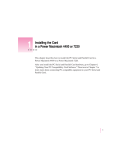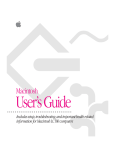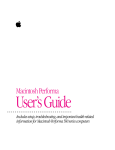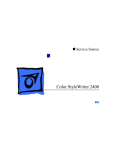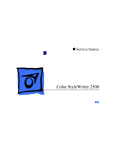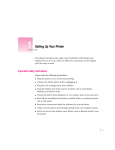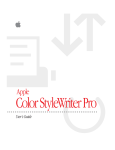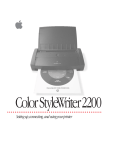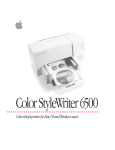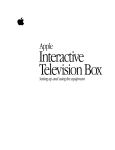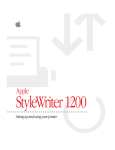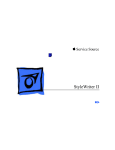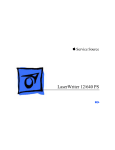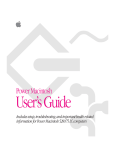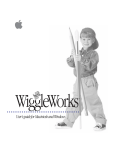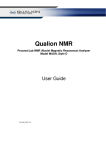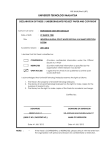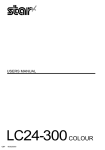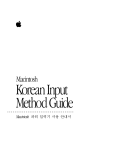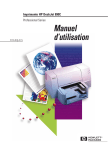Download Apple COLOR STYLEWRITER 2400 User`s guide
Transcript
ColorStyleWriter2400
User’s Guide
K Apple Computer, Inc.
© 1994 Apple Computer, Inc. All rights reserved.
Under the copyright laws, this manual may not be copied, in whole or in part, without the
written consent of Apple. Your rights to the software are governed by the accompanying
software license agreement.
The Apple logo is a trademark of Apple Computer, Inc., registered in the U.S. and other
countries. Use of the “keyboard” Apple logo (Option-Shift-K) for commercial purposes without
the prior written consent of Apple may constitute trademark infringement and unfair
competition in violation of federal and state laws.
Every effort has been made to ensure that the information in this manual is accurate. Apple is
not responsible for printing or clerical errors.
Apple Computer, Inc.
1 Infinite Loop
Cupertino, CA 95014-2084
(408) 996-1010
Apple, the Apple logo, AppleShare, AppleTalk, EtherTalk, LaserWriter, LocalTalk, Macintosh,
PowerBook, StyleWriter, TokenTalk, and TrueType are trademarks of Apple Computer, Inc.,
registered in the U.S. and other countries.
Chicago, ColorShare, ColorSync, the Dogcow logo, Finder, Geneva, MacX25, Monaco, New
York, QuickDraw, and Zeal are trademarks of Apple Computer, Inc.
Adobe, Adobe Illustrator, Adobe Photoshop, Adobe Type Manager, and PostScript are
trademarks of Adobe Systems Incorporated, which may be registered in certain jurisdictions.
Bitstream is a registered trademark of Bitstream, Inc.
Classic is a registered trademark licensed to Apple Computer, Inc.
Delphian is a trademark of Miles, Inc.
ExposurePro is a registered trademark of Baseline Publishing, Inc.
Fontek is a registered trademark of Esselte Pendaflex Corporation in the U.S.A.
Helvetica, Palatino, and Times are registered trademarks of Linotype Company.
ITC Avant Garde, ITC Bookman, ITC Garamond, ITC Lubalin Graph, ITC Machine, ITC Zapf
Chancery, and ITC Zapf Dingbats are registered trademarks of International Typeface
Corporation.
Lucida is a registered trademark of Bigelow & Holmes, Inc.
Nadianne is a trademark of Miles, Inc.
Old English Text is a registered trademark, and Onyx and Swing are trademarks, of Monotype
Corporation plc.
Oxford is a trademark of AlphaOmega Typography, Inc.
QMS is a registered trademark of QMS, Inc.
QuarkXPress is a registered trademark of Quark, Inc.
SuperPaint is a registered trademark of Aldus Corporation.
Tektronix is a registered trademark of Tektronix, Inc.
Simultaneously published in the United States and Canada.
Mention of third-party products is for informational purposes only and constitutes neither an
endorsement nor a recommendation. Apple assumes no responsibility with regard to the
performance or use of these products.
Contents
Communications regulation information
1 Setting Up Your Printer
vi
1
Main features of the Color StyleWriter 2400
Important safety instructions
Unpacking the printer
System requirements
Plugging in the printer
1
2
4
5
6
Turning the printer on and off
Installing the ink cartridge
7
8
Connecting the printer to your Macintosh
Loading paper into the sheet feeder
Checking the print nozzles
12
13
15
Installing your printer software
16
Telling your computer to use the Color StyleWriter 2400
What’s next?
18
19
iii
2 Using Your Printer
21
Loading the sheet feeder
Defining the page setup
Printing a document
22
25
26
Adjusting color options
27
Printing while you use your computer
Checking your printer’s progress
29
30
Sharing your printer with other users
31
Printing on a shared Color StyleWriter 2400
33
Connecting a Color StyleWriter 2400 to a LocalTalk network
3 Tips on Paper, Quality, Speed, and Cost
Choosing print materials
Quality
Speed
Cost
35
35
37
38
38
4 Maintaining Your Printer
39
Replacing ink tanks in the four-color ink cartridge
Replacing the ink cartridge
42
Storing the ink cartridge you aren’t using
Cleaning the outside of the printer
Cleaning the inside of the printer
iv
Contents
47
47
46
39
34
5 Troubleshooting
49
Safety precautions
50
The Chooser doesn’t show the Color SW 2400 icon
Installation is unsuccessful
50
50
The Macintosh doesn’t recognize the Color StyleWriter 2400
Text appears in the Geneva font or prints jagged
Paper is jammed
53
54
55
Paper or envelopes feed improperly
The lights indicate a problem
55
57
The Color StyleWriter 2400 won’t print a particular document
58
The printer acts as if it’s working, but nothing is printed on the page
The printer seems slow
58
Messages appear on your computer screen
Images print poorly
58
59
59
Ink tanks and cartridges run out of ink too quickly
66
Appendix A Technical Information 67
Appendix B Using Fonts With the Color StyleWriter 2400 Printer
Appendix C Packing and Moving the Printer
Appendix D Working With ColorSync
Index
71
85
87
89
Contents
v
Communications regulation information
FCC statement
This equipment has been tested and found to comply with the limits for a Class B digital device
in accordance with the specifications in Part 15 of FCC rules. See instructions if interference to
radio or television reception is suspected.
Radio and television interference
The equipment described in this manual generates, uses, and can radiate radio-frequency
energy. If it is not installed and used properly—that is, in strict accordance with Apple’s
instructions—it may cause interference with radio and television reception.
This equipment has been tested and found to comply with the limits for a Class B digital device
in accordance with the specifications in Part 15 of FCC rules. These specifications are designed
to provide reasonable protection against such interference in a residential installation. However,
there is no guarantee that interference will not occur in a particular installation.
You can determine whether your computer system is causing interference by turning it off. If
the interference stops, it was probably caused by the computer or one of the peripheral devices.
If your computer system does cause interference to radio or television reception, try to correct
the interference by using one or more of the following measures:
m Turn the television or radio antenna until the interference stops.
m Move the computer to one side or the other of the television or radio.
m Move the computer farther away from the television or radio.
m Plug the computer into an outlet that is on a different circuit from the television or radio.
(That is, make certain the computer and the television or radio are on circuits controlled by
different circuit breakers or fuses.)
If necessary, consult an Apple-authorized service provider or Apple. See the service and support
information that came with your Apple product. Or, consult an experienced radio/television
technician for additional suggestions. You may find the following booklet helpful: Interference
Handbook (stock number 004-000-00493-1). This booklet, prepared by the Federal
Communications Commission, is available from the U.S. Government Printing Office,
Washington, DC 20402.
IMPORTANT Changes or modifications to this product not authorized by Apple Computer, Inc.,
could void the FCC Certification and negate your authority to operate the product.
This product was tested for FCC compliance under conditions that included the use of Apple
peripheral devices and Apple shielded cables and connectors between system components. It is
important that you use Apple peripheral devices and shielded cables and connectors between
system components to reduce the possibility of causing interference to radios, television sets,
and other electronic devices. You can obtain Apple peripheral devices and the proper shielded
cables and connectors through an Apple-authorized dealer. For non-Apple peripheral devices,
contact the manufacturer or dealer for assistance.
vi
Communications Regulation Information
DOC statement
DOC Class B Compliance This digital apparatus does not exceed the Class B limits for radio
noise emissions from digital apparatus as set out in the interference-causing equipment standard
entitled “Digital Apparatus,” ICES-003 of the Department of Communications.
Observation des normes—Classe B Cet appareil numérique respecte les limites de bruits
radioélectriques applicables aux appareils numériques de Classe B prescrites dans la norme
sur le matériel brouilleur: “Appareils Numériques,” NMB-003 édictée par le ministre des
Communications.
VCCI statement
Communications Regulation Information
vii
1
Setting Up Your Printer
This chapter introduces the Apple Color StyleWriter 2400 printer and
explains how to set it up. After you follow the instructions in this chapter,
you’ll be ready to print.
Before you begin Make sure that your computer is already set up and that you
know the basics of its operation.
Main features of the Color StyleWriter 2400
m High-quality color graphics and text are printed quietly on a variety of
materials, including plain paper.
m An energy conservation feature turns off the printer when you aren’t using
it and turns it on when needed.
m The automatic sheet feeder holds up to 100 sheets of paper or up to 15
envelopes.
m The ink cartridges are easy to replace.
m ColorShare (installed with the printer software) allows you to share the
printer with anyone on your AppleTalk network (including people using
LocalTalk, EtherTalk, or TokenTalk).
m ColorSync (installed with the printer software) ensures that the colors on
your monitor and on your printer are the best they can be.
m 64 available TrueType (outline) fonts print smoothly in a variety of sizes.
1
Important safety instructions
Always take the following precautions:
m Keep the printer cover closed when printing.
m Always turn off the printer before unplugging it.
m Keep the ink tanks and ink cartridges away from children.
n
Keep the printer away from sources of liquids, such as wash basins,
bathtubs, and shower stalls.
n
Protect the printer from dampness or wet weather, such as rain and snow.
n
Read all the installation instructions carefully before you plug the printer
into a wall socket.
n
Keep these instructions handy for reference by you and others.
n
Follow all instructions and warnings dealing with your computer system.
m Don’t use devices that produce open flames, such as Bunsen burners, near
the printer.
m Don’t use alcohol-based or ammonia-based cleaners on or around the
printer.
m Clean the outside of the printer with only a damp cloth and, if necessary, a
mild soap or detergent. Be careful not to get liquid into the printer or the
power cord receptacle.
2
Chapter 1
Watch for these situations, and if one occurs pull the plug!
n
the power cord or plug becomes frayed or otherwise damaged
n
you spill something into the printer
n
the printer is exposed to rain or any other excess moisture
n
the printer has been dropped or otherwise damaged
n
you suspect that your printer needs service or repair
n
you want to clean the printer (use only the procedure recommended in
Chapter 4)
WARNING Electrical equipment may be hazardous if misused. Operation
of this product, or similar products, must always be supervised by an
adult. Do not allow children access to the interior of any electrical
product and do not permit them to handle any cables.
Setting Up Your Printer
3
Unpacking the printer
1
Remove everything from the shipping box, but leave the ink cartridges in their packages.
Be sure to remove packing
material from the sheet feeder.
Be sure to open the printer’s
cover and remove the packing
tape from inside.
Color StyleWriter 2400
Ink cartridges
(Leave them in the
plastic tubs for now.)
Storage case for ink cartridges
Software disks
Power cord
2
Apple System/Peripheral-8 cable
Remove the tape and packing material from the inside and outside of the printer.
Save the carton and the packing material in case you ever need to ship the
printer. (See Appendix C, “Packing and Moving the Printer.”)
3
4
Chapter 1
Close the printer’s cover.
4
Place the printer in your work area.
Choose a location near your computer that has a grounded electrical outlet
and good ventilation, is out of direct sunlight, never gets damp or very hot or
very cold, and is away from devices that could cause electromagnetic
interference, such as stereo speakers or cordless telephone transmitters. Do
not place the printer on a slanted surface. See Appendix A, “Technical
Information,” for specific information about the physical requirements of your
printer.
Note: Don’t accidentally discard the ink cartridge storage case. You need it to
store an opened cartridge that you’re not using in the printer. The case keeps
the print head from drying out and prevents accidents with ink stains.
System requirements
To install the printer software and use the Color StyleWriter 2400 printer with
your Macintosh computer, you need
m a Macintosh with a 68020 or higher central processing unit (any Macintosh
except a Macintosh Plus, SE, Classic®, Portable, or PowerBook 100)
m system software version 7.0 or a later version
m at least 4 megabytes of random-access memory (RAM)
m some space available on your hard disk (during installation the program
tells you if you need more disk space)
Setting Up Your Printer
5
Plugging in the printer
WARNING This equipment is intended to be electrically grounded. Your
Color StyleWriter 2400 printer is equipped with a three-wire grounding
plug—a plug that has a third (grounding) pin. This plug fits only a
grounded AC outlet. This is a safety feature. If you are unable to insert
the plug into the outlet because the outlet is not grounded, contact a
licensed electrician to replace the outlet with a properly grounded
outlet. Do not defeat the purpose of the grounding plug!
First, insert the
power cord here.
Then plug the power cord into a
grounded outlet or power strip.
IMPORTANT The only way to disconnect power completely is to unplug the
power cord. Make sure that at least one end of the power cord is within easy
reach so that you can unplug the printer in an emergency.
6
Chapter 1
Turning the printer on and off
To turn the printer on (and off), press this button.
This light blinks.
This light glows
while the printer is on.
The first time you turn on the printer, the green power light glows and the
yellow error light blinks because you haven’t installed an ink cartridge yet.
(The next section tells you how to install the cartridge.)
To save power, the printer turns itself off after sitting unused for about 5
minutes. As long as you leave it plugged into an active power outlet, the
printer turns itself on automatically when you print something.
WARNING Except in an emergency, never turn the printer off by
unplugging it unless the power light indicates that the power is off. If
the printer is plugged into a power strip, never turn off the power strip
unless you’ve already turned the printer off.
Each time you turn off the printer, or the printer turns itself off, it
automatically moves the ink cartridge to the right, where it caps the
nozzles to keep the ink cartridges from drying out. If you unplug the
printer or discontinue power before turning it off, the printer can’t
position the cartridge in the capped position, the print head may dry out,
and you’ll have to replace the cartridge.
Setting Up Your Printer
7
Installing the ink cartridge
The ink cartridge contains the print head, which sprays the ink onto the
paper. Treat it gently so you don’t damage its tiny nozzles.
WARNING The carrier holds the ink cartridge and moves it back and
forth when you are printing a document. When the printer is plugged in,
don’t slide the carrier by hand or you may damage the printer.
Before you start, make sure the printer is turned on. (The green light glows,
and the yellow light flashes.)
8
Chapter 1
1
Open the printer by pulling down its front cover.
2
Wait a few seconds until the carrier moves to the center of the printer.
3
Raise the bright blue lever on the carrier.
Carrier
4
Remove the cover from the plastic tub that contains the ink cartridge.
You can install either the black-only cartridge or the four-color cartridge.
(These instructions show the four-color cartridge being installed, but the
process is the same for either cartridge.)
5
Remove the ink cartridge from the plastic tub, grasping it by its sides.
You may touch the black plastic, but be careful not to touch any other part.
6
Remove the bright orange cap from the cartridge’s print head.
After you snap it off,
dispose of the cap.
Setting Up Your Printer
9
7
Peel the orange tape off the print head.
8
Slide the ink cartridge straight into its place in the printer.
Note: There are instructions inscribed inside the printer cover to remind you
how to install either ink cartridge.
10
Chapter 1
9
Lower the lever to secure the ink cartridge in place.
10
Close the printer’s front cover.
Setting Up Your Printer
11
Connecting the printer to your Macintosh
IMPORTANT The serial cable must connect the printer directly to the computer.
Use only the cable that comes with the printer. Replace the cable only with
another Apple System/Peripheral-8 cable that contains special shielding to
prevent interference with radio and television signals.
Plug one end of the
cable into the printer.
(Both ends of the cable
are the same.)
Connect the other end of the
cable to either the printer port
or the modem port, which are
labeled with these icons.
Some Macintosh computers have a
combined serial port with two icons.
If your computer is connected to a network, a network cable may already be
connected to the printer port ([). In that case, use the modem port (W).
Remember which port you use. Later, you must tell the printer software where
to look for the printer.
Some PowerBook computers that have an internal modem installed cannot
tell that the printer is plugged in. You must change a setting in the PowerBook
Setup or Express Modem control panel. For details, see “Telling Your
Computer to Use the Color StyleWriter 2400” later in this chapter.
12
Chapter 1
Loading paper into the sheet feeder
The sheet feeder holds up to 100 sheets of 20-pound paper and feeds the
paper automatically into the printer. You can load many sizes of paper and
other media into the sheet feeder as described in Chapter 2, but to do a nozzle
check, as described in the next section, you must use U.S. letter-size or A4
paper. To load paper into the sheet feeder, follow these steps:
1
Open the printer cover.
2
Adjust the internal paper selector.
Internal paper selector
For paper, start with the
selector in the center position.
For envelopes, move the
selector to the right.
What does the paper selector lever do? The lever has three positions (two for
paper, one for envelopes). In the paper («) positions, the lever lowers the ink
cartridge, bringing it closer for thin materials; in the envelope (E) position,
the lever raises the cartridge to leave room for thick materials. The far-left
position is best for black-and-white text on 20-pound paper; the center
position is best for color printing, for heavy black ink coverage, or for heavier
paper. There’s also a paper-selector lever on the outside of the printer, shown
in step 4. Be sure to adjust both levers to match the material you’re printing
on and the amount of ink you’re using.
Setting Up Your Printer
13
3
Close the printer cover.
4
Load a stack of U.S. letter-size or A4 paper into the sheet feeder.
Slide this guide so it just
touches the edge of the paper.
If the stack of paper bows out
even slightly, the guide is too tight.
Extend this paper support.
Make sure the paper extends
above the support (and doesn’t
slide down inside the printer).
Make sure the paper lines up evenly
at this side of the feeder.
Do not stack paper above this line ( ).
Make sure the external paper selector
is next to the « icon.
To open the output tray, pull here. Be sure to pull it out all the way.
If you’re printing on legal-size paper, don’t open the tray.
14
Chapter 1
Checking the print nozzles
The Color StyleWriter 2400 prints by spraying colored ink onto the paper
through tiny nozzles. Sometimes these small nozzles can get clogged after
sitting unused for a long time. To make sure all the nozzles are working,
follow these steps.
1
If necessary, turn off the printer.
The green power light should be off.
2
Press and hold down the power button until the power light starts to blink.
Press the power button.
When the power light
blinks, release the button.
3
Release the button and wait for the test page to print.
Setting Up Your Printer
15
4
Examine the nozzle test pattern for broken or missing horizontal lines.
The nozzle test pattern appears near the bottom of the test page. The test
pattern for the four-color ink cartridge looks like this:
A broken line means a nozzle on
the print head needs to be cleaned.
A missing color means you need to
replace an ink tank (or the black-only cartridge).
Yellow
Magenta
Cyan
Black
The test pattern for the black-only ink cartridge looks like this:
5
If you see broken or missing lines, one or more nozzles may be clogged. To clear the
nozzle, repeat this nozzle check, starting with step 1.
Installing your printer software
The Color StyleWriter 2400 printer comes with a number of disks that
contain the printer software and an Installer program that copies the software
onto your hard disk. Before you can print your documents, you need to install
the printer software on your Macintosh.
Before you begin If you have virus-protection software, turn it off. Lock all the
disks by turning each one over and sliding the small, square plastic tab so you
can see through the hole. (The disks may already be locked.)
1
Insert the Color StyleWriter 2400 Installation disk into a floppy disk drive.
If necessary, open the disk icon.
16
Chapter 1
2
To start the Installer program, double-click its icon.
3
In the Welcome dialog box that appears, click Continue.
IMPORTANT The Installer determines whether you have the correct system
software and enough memory to use this printer. If you do not, the Installer
displays a message telling you what you need. You won’t be able to install the
printer software until you correct the system software or memory problem. If
the message reports a problem, you can purchase new system software or
memory from an Apple-authorized dealer.
4
In the Installer dialog box, click Install.
Make sure the disk
named here is the
one on which you
want to install the
Color StyleWriter
2400 software.
When you’re ready to
begin, click Install.
After a few minutes, the Installer begins to install the printer software. A
status box keeps you informed of progress during installation.
5
When you see a message on your screen, follow directions and insert the next disk.
The Installer ejects disks and asks you to insert others. Keep following the
instructions on the screen until the installation is complete.
6
When you see a message reporting that installation was successful, click Restart.
The Installer restarts your Macintosh.
More information about the Installer program
In the procedure just described, the Installer copies all the software you need
to your hard disk. In rare circumstances, you may want to copy only a subset
of the software. In that case, choose Custom Install from the pop-up menu in
the Installer. A list of choices appears. To install something from the list, click
to select it, then click the Install button.
Setting Up Your Printer
17
Telling your computer to use the Color StyleWriter 2400
Before using your printer, you must select it in the Chooser.
1
Select Chooser from the Apple (K) menu.
2
In the Chooser dialog box, click items to select them.
On most Macintosh computers, the Chooser looks like this:
Then click one of these
items to indicate which port
you connected the printer to:
the printer port ([) or the
modem port (W).
If no port is available
and your computer is a
PowerBook, see the
information below.
First, click this icon.
(If you don’t see the
icon, use the scroll
bar and arrows
to find it.)
If your computer is
connected to a
network, the Chooser
may look different,
but you can follow
these steps.
3
Close the Chooser by clicking its close box (in the top-left corner).
Special information for PowerBook owners
Some PowerBook computers have a single serial port identified by a
combination printer/modem icon ([/W). If an internal modem is installed on
one of these PowerBook computers, the serial port may be in use even though
it looks available. When you plug in the Color StyleWriter 2400, the
PowerBook may not be able to communicate with the printer.
To make the port available for printing, make sure the serial port setting is
Normal or External. To check the setting, open the PowerBook, PowerBook
Setup, or Express Modem control panel. (The control panel and the setting
you use depend on which PowerBook you have and which internal modem
you have.) If you have a PowerBook Express Modem, it is best to leave the
serial port setting as Normal or External unless the modem programs you use
require another setting for compatibility reasons.
18
Chapter 1
Even when a PowerBook has two serial ports, if it also has an internal
modem, the modem port (W) may look available but actually be in use. If the
printer port ([) is available, connect the Color StyleWriter 2400 to it. If the
printer port is unavailable and you must use the modem port, make sure the
modem serial port setting is Normal or External. To check the setting, open
the PowerBook, PowerBook Setup, or Express Modem control panel. (The
control panel and the setting you use depend on which modem and system
software version you have.) If you have an Express Modem, it is best to leave
the serial port setting as Normal or External.
For more information, see the manual or on-screen help that came with your
PowerBook.
What’s next?
To start printing and verify that the connection between your Color
StyleWriter 2400 and the Macintosh is working, go on to Chapter 2.
Setting Up Your Printer
19
2
Using Your Printer
When your printer is set up (plugged in, loaded with paper, and selected in
the Chooser), you are ready to print. Printing can be as simple as choosing
Print from the File menu. You can also make optional changes to parts of the
printing process. You can
m load the printer with different kinds of paper, envelopes, or other materials
m change your page setup (page size, orientation, and scale)
m choose the results you prefer when printing in color
If your computer is connected to other Macintosh computers over a network,
you can also
m share your Color StyleWriter 2400 printer with others on the network
m use another Color StyleWriter 2400 on the network
This chapter tells you how to carry out these tasks with your Color
StyleWriter 2400.
21
Loading the sheet feeder
The sheet feeder holds paper, envelopes, or other materials and feeds them
automatically into the printer. To load the sheet feeder, follow these steps:
1
Adjust the external paper selector and load the paper.
IMPORTANT Don’t mix envelopes with paper in the feeder.
Insert letterhead paper face up
with the top of the page pointing
downward.
Slide this guide so
it just touches the
edge of the paper.
If the stack of paper bows
out even slightly,
the guide is too tight.
Extend this paper support.
Make sure the paper extends
above the support (and doesn’t
slide down inside the printer).
Insert envelopes this way.
(Make sure the flap is
smoothed flat.)
Insert three-hole punched paper so
that the holes line up along this side.
Make sure the paper lines up
evenly at this side of the feeder.
Don’t stack paper above this line ( ).
Move the paper selector lever to the
envelope icon (E) for envelopes
and to the paper icon («) for
everything else.
22
Chapter 2
If you’re changing print materials (from paper to envelopes, for example),
continue with steps 2 through 4.
2
Open the printer’s front cover.
Wait while the carrier moves to the center position.
3
Adjust the internal paper selector and extend the output tray.
The lever has three positions (two for paper, one for envelopes). In the paper
(«) positions, the lever lowers the ink cartridge, bringing it closer for thin
materials; in the envelope (E) position, the lever raises the cartridge to leave
room for thick materials. The far-left position is best for black-and-white text
on 20-pound paper; the center position is best for color printing, for heavy
black ink coverage, or for heavier paper.
Internal paper selector
For paper, start with the
selector in the center
position. For envelopes,
move the selector
to the right.
To open the output
tray, pull here. (For
legal-size paper, leave
the tray closed.)
4
Close the printer cover.
Using Your Printer
23
Here are details about the kinds of material you can use in your
Color StyleWriter 2400 printer.
Print material
Maximum
Special instructions
Plain paper
100 sheets
m Use 16- to 24-pound paper.
Premium coated paper
20 sheets
m Use only paper designed for this printer.
m The whiter side should face you.
Glossy paper
20 sheets
m Use only paper designed for this printer.
m To prevent misfeeds, put one sheet of plain paper at
the back of the stack.
m The shinier side should face you.
Envelopes
15
m Make sure the envelope flap is smoothed flat.
Transparencies
20
m Use only transparencies designed for this printer.
m The shiny side should face you.
m The edge where the paper and transparency are
joined should point downward.
Back-print film
20 sheets
m Use only film designed for this printer.
m To prevent misfeeds, put one sheet of plain paper
at the back of the stack.
m The chalky side should face you.
Labels
20 sheets
m To prevent misfeeds, put one sheet of plain paper
at the back of the stack.
m The labels should face you.
m In the Print dialog box, specify Plain as the paper
type.
For more information on the kinds of material you can use with your
Color StyleWriter 2400, see Chapter 3, “Tips on Paper, Quality, Speed,
and Cost.”
24
Chapter 2
Defining the page setup
Almost every Macintosh program has a Page Setup command in the File
menu. You can use this command to set a variety of options, from changing
the page size to applying visual effects. The most common options are already
selected for you, so choose Page Setup only if you want to change them.
1
Choose Page Setup from the File menu.
The Page Setup dialog box appears, as shown in the next step. The dialog box
you see may not exactly match the illustration, but it works basically the same
way.
2
In the dialog box, make the selections you want.
Use this pop-up menu to identify the
paper or envelope size you are using.
To enlarge or reduce the
size of the printed image,
choose from this pop-up
menu. (Or you can enter
a number.)
For vertical orientation
(also called portrait), click here.
3
For horizontal orientation
(also called landscape), click here.
When you’ve made your choices, click OK.
Your document is now set up for printing.
Using Your Printer
25
Printing a document
To print a document, follow these steps:
1
Open the document you want to print, or select its icon in the Macintosh Finder.
2
Choose Print from the File menu.
A dialog box appears, displaying a number of printing options.
3
Set any options you like.
The most common choices are already set for you.
Click Best for highest quality, Normal for typical use,
or Draft for lower ink consumption. For plain and coated
paper, you can use any of these three choices; for other
materials, you must use Best quality.
Use this pop-up menu
to identify the type
of material you’ve
loaded into the
printer. (For labels
and envelopes,
choose Plain.)
For a visual alert, choose
Message from this pop-up
menu; for an audio alert,
choose a sound.
Choose Color, Grayscale,
or Black & White from this
pop-up menu.
You can use the Color button to adjust the color options for the document
you’re printing. See the next section, “Adjusting Color Options.”
4
When you are satisfied with the settings, click Print.
If necessary, the printer turns itself on; after a few moments, the printer
begins printing your document.
IMPORTANT Don’t open the printer cover while the document is printing.
(This can waste ink and cause a paper jam.)
26
Chapter 2
Adjusting color options
To adjust the way colors are printed, follow these steps:
1
Choose Print from the File menu.
2
In the dialog box that appears, click Color.
Click Color.
Some programs provide a second box you must click before the color options
dialog box opens. See the Read Me file for information about printing in
color with specific programs.
3
Select your color options.
The printer blends the four ink colors
in either a repeating pattern of dots
or a random scattering of dots.
Choose the halftoning method you prefer.
To turn on color
matching and get the
best quality color
printing, check the
ColorSync box.
The ColorSync color-matching system makes sure that colors look consistent
no matter what device you use to view them—monitor or printer. In addition,
ColorSync helps give you the best possible colors when you export the image
to another Macintosh with ColorSync installed or print it on another color
printer.
Note: If you have a color PowerBook, open the ColorSync control panel and
make sure the system profile is correct for your PowerBook. If it’s not, choose
Set System Profile from the pop-up menu and select the correct profile.
Using Your Printer
27
With ColorSync turned on and the Automatic matching method selected, the
Macintosh chooses the best matching method for the contents of the
document you are printing. If you need to override the automatically selected
color-matching method, you can choose the option you want from the
Matching Method pop-up menu. Most of the time, however, the Automatic
setting is best.
Automatic lets the Macintosh
choose the best color-matching
method for your document.
If you have obtained additional printer profiles from other software
companies, you can use the Printer Profile pop-up menu to choose the one
you want. (The additional profiles should come with instructions telling you
how to choose the appropriate one.)
If you don’t have additional printer profiles,
leave this set to Automatic.
4
Once you’ve made your choices, click OK to return to the Print dialog box.
5
Click Print.
6
To save the ColorSync settings with this document, choose Save from the File menu.
For more information on ColorSync, see Appendix D.
Color printing quirks
Here is some additional information about color printing.
m Different programs may define colors in different ways. When you choose
a red in one program, you may not be able to find an exact match in
another program. You can adjust the color in the second program until
you’re satisfied with the printed results. To see how different programs
define color, consult the manuals that came with your programs.
m Color printing takes longer than black-and-white printing. The printer must
sort through more data and use more ink to complete the job, and this
takes time.
28
Chapter 2
Printing while you use your computer
You can continue to work on your computer while printing on the
Color StyleWriter 2400. The feature that gives you this ability is called
background printing, and is automatically turned on when you install your
Color StyleWriter 2400 software.
To turn background printing on or off, follow these steps:
1
Select Chooser from the Apple (K) menu.
The Chooser opens.
2
Click the Color SW 2400 icon in the Chooser.
Click this icon.
If you don’t see the
icon, click this arrow
until it appears.
3
Click to turn background printing on or off.
Click On or Off.
4
Click the close box in the upper-left corner of the Chooser.
Once background printing is turned on, it is in effect whenever you print,
until you turn it off. When you click Print in the Print dialog box, a message
appears on your screen and then disappears. You can then continue other
work. Your computer may pause occasionally while it processes the document
for printing.
Using Your Printer
29
Checking your printer’s progress
While a document is being printed in the background, you can use
PrintMonitor to check its progress. In addition, PrintMonitor lets you know
when there’s a problem. (PrintMonitor is a program that’s part of the
Macintosh system software.)
1
While the document is printing, choose PrintMonitor from the Application menu at the far
right of the menu bar.
PrintMonitor is available only when
background printing is on.
If you turn off background printing,
messages on your screen keep you
informed of printing status.
2
In the PrintMonitor dialog box, review the status of documents that are printing (and
make any changes you want).
The document that’s
currently printing
appears here.
Documents that are waiting
to print are listed here.
To cancel the current
print job, click here.
To schedule a specific time for a
document to print, click its name in
the list, then click Set Print Time.
Comments about
the status of the
document being
printed appear here.
3
30
Chapter 2
When you finish, click the close box.
Sharing your printer with other users
If your computer is connected to other computers over an AppleTalk
network, you can allow other users on the network to print on your
Color StyleWriter 2400. The technology that lets you do this is
called ColorShare.
To share the printer with other users, follow these steps:
1
Select Chooser from the Apple (K) menu.
2
In the Chooser dialog box, make the changes you want.
First, click this icon.
(If you don’t see the
icon, use the scroll
bar and arrows to
find it.)
Then click Setup.
3
In the sharing setup dialog box, make the changes you want.
To share your printer,
click to place an X in
this box.
Type a name for
your printer here.
(To avoid
confusion, give it
a unique name.)
To make your printer available
only to people you choose, type
the password here.
To use your printer, others must type
the password exactly as you have, so
remember how you typed the word,
including where you used uppercase
and lowercase letters or spaces before
or after the word.
Using Your Printer
31
4
To keep a record of what’s printed on your printer, click the “Keep Log of Printer Usage”
checkbox to put an X in it.
You can open and print the log with SimpleText, TeachText, or another wordprocessing program. To find the log file, open your System Folder; then open
the Preferences folder, and open the Printing Prefs folder.
Note: You can keep a log even if your printer is not shared.
5
Click OK to close the sharing setup dialog box.
Sharing works only if background printing is turned on. If it is not turned on,
ColorShare turns it on.
6
Close the Chooser (click the close box in the upper-left corner).
If Color StyleWriter 2400 software has been installed on their Macintosh
computers, other users connected to the network can now use
your Color StyleWriter 2400. (For information about installing the
Color StyleWriter 2400 software, see Chapter 1.)
IMPORTANT For others to be able to use the shared Color StyleWriter 2400
printer, your Macintosh must be turned on.
32
Chapter 2
Printing on a shared Color StyleWriter 2400
After you turn on sharing (as described in the previous section), others on
your network can share your printer.
People on the network who want to print on your shared printer must install
the Color StyleWriter 2400 software on their computers, as described in
Chapter 1. Then they must follow these steps:
1
Select Chooser from the Apple (K) menu.
The Chooser opens.
2
First, click this icon.
(If necessary, use the
scroll bar and arrows
to find the icon.)
Second, if the
network has zones,
click one to select it.
3
Make selections in the Chooser.
Third, click the name
of the printer you
want to use. If the
printer requires a
password, a dialog
box appears asking
you to type it.
Close the Chooser (click the close box in the upper-left corner).
Anyone who completes these steps can print on the shared
Color StyleWriter 2400.
Note: When other users print on a printer connected to your Macintosh while
you are using your computer, you may notice that your computer pauses
occasionally. Because the printer is attached to your Macintosh, you can use
PrintMonitor to see what’s being printed (and by whom).
Using Your Printer
33
Connecting a Color StyleWriter 2400 to a LocalTalk network
If you have the optional Color StyleWriter 2400 LocalTalk Module, you can
connect a Color StyleWriter 2400 printer to a LocalTalk network.
To attach the LocalTalk Module and connect your Color StyleWriter 2400 to
the network, follow the instructions that come with the module. Once the
printer is on the network, its name appears in the Chooser just like other
network printers.
If you want to change the name, click Rename. In the dialog box that appears,
type a new name for the Color StyleWriter 2400 printer. (Note: Anyone on the
network can change the name.)
Type a new name,
then click Rename
(or press Return).
34
Chapter 2
3
Tips on Paper, Quality, Speed, and Cost
This chapter explains how to use different materials and printing options to
meet your needs.
Choosing print materials
Here are some tips on when and how to use different print materials.
Plain paper
Use plain paper for everyday printing.
m Print quality may vary depending on the manufacturer of the paper.
If you’re not happy with one kind of paper, try a different brand.
For consistent results, use one of the special papers designed for the
Color StyleWriter 2400 printer.
m You can use any plain paper, including plain copier paper. Paper weight
can range from 16 to 24 pounds, though 20-pound paper is recommended.
m Don’t use erasable typing paper, damaged or wrinkled paper, stapled paper,
or multipart forms (“carbonless carbons”).
m Plain paper almost always has one side that is better for printing than the
other. See the package label to determine which side is better, and load that
side so that it faces you.
35
Premium coated paper
Use premium coated paper for exceptional print quality—for example, for a
final draft, a colorful notice, or the master copy of a presentation. Colors
appear richer and more vibrant on such paper.
m Use only coated paper designed for use with the Color StyleWriter 2400.
m One side of the paper is a little whiter than the other and is better for
printing. See the package label on the coated paper to determine which
side is better, and load that side so that it faces you.
Glossy paper
Use glossy paper for the highest print quality you can get on opaque paper—
for example, for color proofs.
m Use only glossy paper designed for use with the Color StyleWriter 2400.
m When loading a stack of glossy paper into the sheet feeder, put a single
sheet of plain paper at the back of the stack to prevent misfeeding.
Back-print film
Use back-print film for the highest print quality of all—for example, for
digitized photographs or important client presentations. Back-print film has a
shiny surface and works exceptionally well when displayed by backlighting.
m Use only back-print film designed for use with the Color StyleWriter 2400.
m Load back-print film so that the chalky side faces you.
m When loading a stack of back-print film into the sheet feeder, put a single
sheet of plain paper at the back of the stack to prevent misfeeding.
m In the Print dialog box, be sure to select Back Print as the paper type.
m The printer automatically reverses the image and prints it on the film’s
chalky side so that the image looks correct when viewed from the shiny
side.
36
Chapter 3
Transparencies
Use transparencies when you want to present your document on an overhead
projector.
m Use only transparencies designed for use with the Color StyleWriter 2400.
These special transparencies have a sheet of paper attached to them; leave
the paper attached until after printing.
m Load the transparencies so that the shiny side faces you and the edge
where the paper and the transparencies are attached points downward.
Quality
For highest-quality printing, use the following selections in the Print dialog
box. (To display the dialog box, choose Print from the File menu.)
Select Best quality.
Best quality takes
longer to print, but
you get dramatically
better quality—even
on plain paper.
Print on coated or glossy paper, back-print film, or transparencies.
Also consider the following selections in the Color Options dialog box. (To
display the dialog box, click the Color button in the Print dialog box.)
To turn on color
matching and get the
best quality color
printing, check the
ColorSync box.
Many people prefer the
look of the Scatter
halftoning method.
For more information on color matching, see “Adjusting Color Options” in
Chapter 2.
Tips on Paper, Quality, Speed, and Cost
37
Speed
For faster printing, change the Print Quality setting in the Print dialog box.
(To display the dialog box, choose Print from the File menu.)
Select Normal or Draft.
Draft is faster than
Normal.
Also use the following selections in the Color Options dialog box. (To open
the Color Options dialog box, click the Color button in the Print dialog box.)
Select Pattern.
Turn off ColorSync.
Color printing takes longer than black-only printing.
The black-only ink cartridge is designed for efficient, high-speed black and
grayscale printing. If you’re printing 20 or more pages in black or grayscale,
use the black-only cartridge.
Cost
To reduce the amount of ink you use, select Draft quality in the Print dialog
box whenever possible.
Leave the printer’s cover shut. (Every time you open and shut the cover, the
printer uses ink to clean the print head.)
Don’t unplug the printer unnecessarily or connect it to a power strip that you
turn off occasionally. When you plug the printer in again, it uses ink as it
cleans the print head.
Switching cartridges uses extra ink. Don’t switch cartridges unnecessarily.
38
Chapter 3
4
Maintaining Your Printer
It doesn’t take much effort to keep your Color StyleWriter 2400 printer in
good working condition. You simply have to replace the ink cartridges (or
their ink tanks) when they run out of ink and clean the printer or print head
if you notice a problem.
For other service, see the information about service and support that comes
with your Color StyleWriter 2400.
IMPORTANT Follow all the safety instructions given at the beginning of
Chapter 1.
Replacing ink tanks in the four-color ink cartridge
The four-color ink cartridge contains two separate ink tanks, one for black
ink and one for cyan, magenta, and yellow inks. This means that when you
run out of black ink, you don’t have to replace both tanks. (Most people use
more black ink than any other color.)
WARNING Use only ink specially designed for the Color StyleWriter
2400. The wrong ink can damage the print head and the printer, and
such damage is not covered under the warranty.
39
When to change ink tanks
Look carefully at your printed documents to see if a color is missing or faded.
Sometimes it’s obvious—such as when you run out of black ink. At other
times you may notice that the colors seem wrong—such as when you’re
printing a nature scene and you run out of yellow.
The best way to verify that ink is running low is to print the test page. (For
details, see “Checking the Print Nozzles” in Chapter 1.)
Note: Depending on how much printing you have done with your current
four-color ink cartridge, this may be a good time to replace the entire
cartridge. (A new four-color cartridge comes with fresh ink tanks installed.)
How to change ink tanks
1
Turn on the printer.
2
Open the printer’s front cover.
Wait while the carrier moves to the center position.
3
40
Chapter 4
Remove and discard the old ink tank.
4
Remove the new ink tank from its packaging.
5
Remove the plastic cap from the ink tank.
Don’t let anything touch
the openings. The ink
may cause stains, and
any contaminants may
harm the print quality.
6
Slide the tank into the cartridge, and push it down so it snaps into place.
IMPORTANT Make sure you put the color ink tank on the left and the black ink
tank on the right.
7
Close the printer cover.
Maintaining Your Printer
41
Replacing the ink cartridge
The ink cartridge contains the print head, the device that takes the ink and
sprays it on the paper. The Color StyleWriter 2400 printer comes with two
ink cartridges: a four-color cartridge with replaceable ink tanks and a highperformance, black-only cartridge. The black-only cartridge lasts for about
900 typed pages—until it runs out of ink. The four-color cartridge lasts about
twice as long, because you can replace its ink tanks.
When to replace the black-only ink cartridge
Knowing when to replace the black-only cartridge is fairly simple. When it
runs out of ink, it stops printing.
Note: If you see other problems with black-only print quality, such as
unwanted white lines in a document, try printing the test page. (See “Printing
the Test Page” in the section “Images Print Poorly” in Chapter 5.)
When to replace the four-color cartridge
Age is the primary factor in determining when a four-color cartridge wears
out. If you’ve done a lot of printing with your cartridge and notice a gradual
deterioration in print quality, it may be time to install a new four-color ink
cartridge. Before you do, try printing the test page in case a clogged nozzle is
the problem. (See “Printing the Test Page” in the section “Images Print
Poorly” in Chapter 5.)
Note: A new four-color ink cartridge comes with fresh ink tanks already
installed.
How to find ink cartridges
You should be able to find cartridges, ink tanks, and other supplies for your
Color StyleWriter 2400 printer at any Apple-authorized reseller.
42
Chapter 4
How to replace the ink cartridge
IMPORTANT Before replacing the cartridge, try printing the test page. (See
“Printing the Test Page” in the section “Images Print Poorly” in Chapter 5.)
1
Turn on the printer.
2
Open the printer’s cover.
Wait while the carrier moves to the center position.
3
Raise the bright blue lever on the carrier and remove the cartridge.
Dispose of the cartridge.
IMPORTANT Be careful not to touch the print head, or you may temporarily
stain your fingers with ink.
Carrier
4
Remove the cover from the plastic tub that contains the new cartridge.
5
Remove the ink cartridge from the plastic tub.
You may safely touch the black plastic, but be careful not to touch any other
part.
Maintaining Your Printer
43
6
Remove the bright orange cap from the cartridge’s print head.
After you snap it off,
dispose of the cap.
7
44
Chapter 4
Peel the orange tape off the print head.
8
Slide the cartridge into its place in the printer.
9
Lower the bright blue lever on the carrier to secure the cartridge in place.
10
Close the printer cover.
Now you can open any document you want and print it as usual.
Maintaining Your Printer
45
Storing the ink cartridge you aren’t using
The Color StyleWriter 2400 comes with two ink cartridges, a black-only and a
four-color cartridge. While they are sealed in their original packaging, the ink
cartridges are protected. If you open both packages and switch ink cartridges
for printing different documents, be sure to store the one you’re not using in
the storage case supplied with your Color StyleWriter 2400. The storage case
keeps the print head from drying out and prevents accidents with ink stains.
Be careful not to touch this area on the ink
cartridge, or you may stain your fingers with ink.
Once you’ve removed both cartridges from their original packages, always
keep one inside the printer and the other in the storage case.
46
Chapter 4
Cleaning the outside of the printer
Before you clean the printer, turn it off and unplug the power cord. Then
wipe the outside of the printer with a clean, soft cloth dampened with water.
If necessary, you can use a mild soap or detergent. Be careful not to get any
liquid in the power cord receptacle.
WARNING Don’t use ammonia-based or alcohol-based cleaners on or
around the printer—they may react with the plastic.
Cleaning the inside of the printer
Occasionally you may need to wipe off paper dust or drops of ink inside the
printer. Turn the printer off and unplug it. Then open the printer and carefully
clean the rollers and platen with a soft, dry cloth.
If necessary, you
can clean the rollers
and platen with a
soft, dry cloth.
WARNING Don’t use any liquid cleaners inside the printer.
Maintaining Your Printer
47
5
Troubleshooting
This chapter provides solutions to some problems that you may encounter
while using your Color StyleWriter 2400 printer.
As long as you follow the maintenance instructions in Chapter 4, you’re not
likely to have any problems with your Color StyleWriter 2400. The most
common source of trouble is faulty software installation. To avoid these
problems, follow the software installation instructions in Chapter 1.
WARNING If you have a problem with your Color StyleWriter 2400
printer and nothing presented in this chapter solves it, consult the
service and support information that came with your Apple product for
instructions on how to contact an Apple-authorized service provider or
Apple for assistance. If you attempt to repair the Color StyleWriter 2400
yourself, any damage you may cause to the printer will not be covered
by the limited warranty on your printer. Contact an Apple-authorized
dealer or service provider for additional information about this or any
other warranty question.
49
Safety precautions
To prevent damage to the Color StyleWriter 2400 printer and harm to yourself
and other users, follow these safety tips.
m Don’t touch anything inside the printer except as described in the
instructions in this manual. Otherwise, you may damage delicate
mechanical parts.
m Don’t shake ink tanks or hold them with the ink opening pointing down.
Ink can leak out and cause stains.
m Don’t touch the ink opening on an ink tank.
m Don’t oil the inside of the printer.
m Don’t attempt to disassemble the printer.
m Before you unplug the printer, make sure it is turned off. (The green power
light should be off.) Turning the power off ensures that the carrier has
returned securely to its home position and the cartridge has been capped.
The Chooser doesn’t show the Color SW 2400 icon
You use the Chooser desk accessory to identify the printer you intend to use.
If the Color SW 2400 icon is missing from the Chooser dialog box, you
probably need to install the appropriate printer software. For instructions, see
“Installing Your Printer Software” in Chapter 1.
Installation is unsuccessful
If a message tells you that installation was not successful, try turning off your
extensions before you install the software. Press and hold down the Shift key
as you choose Restart from the Special menu. The Macintosh restarts with all
extensions turned off, and you can repeat the installation procedure. For
instructions, see “Installing Your Printer Software” in Chapter 1.
If you still cannot install the printer software, the problem may be caused by
fonts in your Fonts folder. To solve this problem, you can remove items from
your Fonts folder or do a custom installation, as described in the next two
sections.
50
Chapter 5
Removing items from your Fonts folder
Items in your current Fonts folder can interfere with successful installation of
the printer software. To correct the problem, follow these steps:
1
Open the Fonts folder (inside the System Folder) on your Macintosh.
2
Remove from the Fonts folder any file that has the same name as one of the fonts that
comes with your Color StyleWriter 2400.
These are the fonts that come with your printer software:
m ITC Avant Garde®
m ITC Bookman®
m Delphian
m ITC Garamond®
m Helvetica® Black, Helvetica Compressed, and Helvetica Narrow
m ITC Lubalin Graph®
m Lucida Bright
m ITC Machine®
m Nadianne
m Old English Text
m Onyx
m Oxford
m Palatino®
m Swing
m ITC Zapf Chancery® and ITC Zapf Dingbats®
m Zeal
You can put the fonts temporarily into a new folder and drag the folder to
your desktop. Then, after you install the Color StyleWriter 2400 software
(including these fonts), you can drag the temporary folder to the Trash.
3
Repeat the installation procedure.
For instructions, see “Installing Your Printer Software” in Chapter 1.
For more details about fonts, see Appendix B.
Troubleshooting
51
Using the Custom Installer
You can install the printer software without installing the fonts that come
with the printer. (The disadvantage is that you won’t be able to use these fonts
if you don’t already have them.)
1
Insert the Color StyleWriter 2400 Installation disk into a floppy disk drive.
If necessary, open the disk icon.
2
To start the Installer program, double-click its icon.
3
In the Welcome dialog box that appears, click Continue.
4
In the Installer dialog box, choose Custom Install.
Choose Custom
Install from this
pop-up menu.
5
In the Custom Install dialog box, click the first checkbox.
Click this checkbox.
(An X appears to
show it’s selected.)
Make sure the disk
named here is the
one on which you
want to install the
Color StyleWriter
2400 software.
52
Chapter 5
When you’re ready to
begin, click Install.
6
When you see a message on your screen, follow the directions and insert the next disk.
The Installer ejects disks and asks you to insert others. Keep following the
instructions on the screen until the installation is complete.
7
When you see a message reporting that installation was successful, click Restart.
The Installer restarts your Macintosh.
The Macintosh doesn’t recognize the Color StyleWriter 2400
If you have selected the Color StyleWriter 2400 printer in the Chooser but
nothing prints, or you get a message that no Color StyleWriter 2400 is
connected, one of the following conditions may be the cause:
m A plug is loose. Make sure that all cables are properly connected. See the
instructions in Chapter 1 for setting up your Color StyleWriter 2400.
m You may have indicated the wrong port in the Chooser. Open the Chooser
and change the port selection. (If possible, check to see whether you
plugged the printer into the computer’s printer port [[] or modem port
[W], then make sure that you indicate the same port in the Chooser.)
m If you are trying to use a shared printer connected to another Macintosh
and the printer name isn’t listed in the Chooser, make sure that the other
Macintosh is turned on and connected to the network. Also make sure that
the printer is set up to be shared. Then try again to select the printer in the
Chooser. See the instructions in “Sharing Your Printer With Other Users”
in Chapter 2.
m If you’re using a PowerBook computer with an internal modem, change the
serial port setting to Normal or External. For details, see “Special
Information for PowerBook Owners” in the section “Telling Your
Computer to Use the Color StyleWriter 2400” in Chapter 1.
If you still can’t resolve the problem, the printer may not be working properly.
See the information about service and support that comes with your printer.
Troubleshooting
53
Text appears in the Geneva font or prints jagged
When your Macintosh computer is low on memory, it may display and print
certain fonts in the Geneva font. (Geneva looks like this.) Some text may also
have jagged edges.
One easy way to make more memory available is to quit open programs you
aren’t using. For other suggestions on how to free up memory, see the
documentation that came with your computer or with your latest system
software upgrade. You can also consult an Apple-authorized service provider
about installing more memory in your Macintosh.
For more information about fonts, see Appendix B, “Using Fonts With the
Color StyleWriter 2400 Printer.”
Some rotated text may print jagged if you apply a style that has not been
defined for the font. Try applying plain style to the text.
54
Chapter 5
Paper is jammed
Occasionally a piece of paper may get jammed (stuck) inside the printer
during the printing process. To clear a paper jam, follow these steps:
1
If necessary, open the printer to see where the jam is.
2
Gently pull the paper free.
Paper or envelopes feed improperly
If paper tears, gets skewed, or comes through the printer crumpled, it may not
be entering the printer properly. Try the following:
m Make sure you have loaded the paper correctly, paying special attention to both paper
selectors.
For instructions on loading paper, see “Loading the Sheet Feeder” in
Chapter 2.
m Do not overload the sheet feeder.
The feeder holds up to 15 envelopes or up to 100 sheets of 20-pound paper.
If you use heavier paper, fewer sheets will fit in the feeder.
m Do not force paper into the sheet feeder.
Troubleshooting
55
m Try to remove any torn or damaged pieces of paper from the printer.
See the previous section, “Paper Is Jammed.”
m Take the paper out of the sheet feeder and check it.
Make sure none of the sheets is curled, bent, or dog-eared.
Make sure the edges of the stack line up evenly.
Make sure the left paper guide isn’t too snug or too loose. The stack should
lie flat (not bowed).
Make sure the paper doesn’t slide down into the printer.
Load either envelopes or paper (not both) into the sheet feeder.
Make sure you have inserted envelopes correctly. The flaps should lie flat
against the envelope, the edges should be smoothed flat, and no air should
be trapped in the envelopes.
When loading back-print film, put a sheet of plain paper at the back of
the stack.
When loading transparencies, the shiny side should face you. The edge
where the paper and the transparency are joined should point downward.
56
Chapter 5
The lights indicate a problem
Power button (I)
Error light (‘)
Power light
Sometimes the lights on the printer signal a problem.
m Both lights are off. To conserve energy, the printer turns itself off if it’s left
idle for some time (usually about 5 minutes). If you suspect a problem,
press the power button. If the lights remain off, check to make sure the
power cord is plugged in properly and the outlet has power. If you can’t
turn the printer lights on, see the information about service and support
that comes with the printer.
m The error light glows steadily. Either the printer is out of paper or the paper
has misfed. Check your computer screen for messages. See Chapter 2 for
instructions on loading the sheet feeder, or “Paper Is Jammed” and “Paper
or Envelopes Feed Improperly” earlier in this chapter.
m The error light blinks. The ink cartridge may not be seated properly. Open the
printer’s cover. Make sure the cartridge is inserted properly, and that the
bright blue lever is firmly lowered to secure the cartridge in place. For
instructions, see “Installing the Ink Cartridge” in Chapter 1.
Troubleshooting
57
The Color StyleWriter 2400 won’t print a particular document
If you attempt to print a document and no page is printed, try the following:
m Check for messages on your Macintosh screen. (If necessary, open
PrintMonitor, which is available in the Application menu at the top right
corner of the screen.)
m Turn the printer off, then on again. (This resets the printer.)
m Repeat the printing process.
Sometimes problems disappear when you try to print your document again.
m Try printing from another program.
m Restart your Macintosh.
The printer acts as if it’s working, but nothing is printed on the page
If your printer takes the paper, but doesn’t actually print anything, try the
following:
m Make sure the ink cartridge and the ink tanks in the four-color cartridge
are correctly installed. (For instructions, see “Replacing Ink Tanks in the
Four-Color Ink Cartridge” and “Replacing the Ink Cartridge” in Chapter 4).
m To make sure the printer is not out of ink, print the test page. For
instructions, see “Checking the Print Nozzles” in Chapter 1.
m If the ink cartridge is new, make sure that you removed the tape from its
print head.
m Try cleaning the print head or printing the test page. For instructions, see
“Unwanted Horizontal White Lines or Stripes Appear” in the section
“Images Print Poorly,” later in this chapter.
The printer seems slow
See the suggestions in “Speed” in Chapter 3.
If you have a Macintosh IIfx or Macintosh Quadra 950 computer, check the
Serial Switch control panel. Make sure the setting is “Compatible.”
Note: The printer automatically takes a few moments to clean the print head
when it is plugged back in or after more than three days of inactivity.
58
Chapter 5
Messages appear on your computer screen
Most messages that appear on your screen are self-explanatory. For example,
they may tell you that the printer is out of paper or that the paper is jammed.
Once you correct the problem, the message goes away.
Here are some other problems that on-screen messages might report:
The waste ink container in the printer is full.
From time to time, the printer deposits some ink into a waste container. In the
rare event that the container becomes full, Apple recommends that you take
the printer to an Apple-authorized service provider.
There is an error in the printer.
Check to make sure the cable is still connected to the printer and the
computer. Also, the ink cartridge may not be seated properly. Turn on the
printer and open the printer’s cover. Make sure the cartridge is inserted
properly, and that the blue lever on the side of the carrier is firmly lowered to
secure the cartridge in place.
Images print poorly
Most image problems are caused by problems with an ink cartridge or with
your choice of paper. Don’t use the following types of paper:
m erasable typing paper
m damaged, wrinkled, or stapled paper
m multipart forms (“carbonless carbons”)
For best print quality, use coated or glossy paper or back-print film. If you
use plain paper, use 16- to 24-pound copier paper; 20-pound paper is
recommended. Plain papers can vary widely. If you’re not happy with one
kind of paper, try a different brand.
Colors skip or streak at the bottom of the page
If you’re not happy with the quality of printing near the bottom of a page,
change the setting for the bottom margin to 0.8 inch.
Troubleshooting
59
The image is too light or too dark
If printing looks fuzzy because it’s too light or too dark, try the following:
m Check the nozzles in the print head. See “Checking the Print Nozzles” in
Chapter 1 for instructions. If this doesn’t help, replace one or more ink
tanks in the four-color ink cartridge, or replace the black-only cartridge.
See “Replacing Ink Tanks in the Four-Color Ink Cartridge” and “Replacing
the Ink Cartridge” in Chapter 4 for instructions.
m Make sure you’ve chosen the correct paper type in the Print dialog box.
m Try flipping the stack of paper in the paper tray. Most paper has one side
that’s better for printing.
m Try printing on a different kind of paper.
m Try choosing Best quality in the Print dialog box.
m Make sure that both paper selectors (one inside the printer, the other on the
sheet feeder) are set to the correct position. See “Loading the Sheet
Feeder” in Chapter 2.
Ink smears when rubbed
Don’t handle pages before the printer ejects them from the printer and
delivers them into the output tray. This allows all the time needed for the ink
to dry.
Pages leave the printer smeared, blurred, or smudged
The print head may be too close to the paper it’s printing on. Move the
internal paper selector to the envelope (=) position. See “Loading the Sheet
Feeder” in Chapter 2.
60
Chapter 5
Printing appears on only part of the paper
Check the selections in the Page Setup dialog box.
Check the nozzles in the print head. See “Checking the Print Nozzles” in
Chapter 1 for instructions. If this doesn’t help, replace one or more ink tanks
in the four-color ink cartridge, or replace the black-only cartridge. See
“Replacing Ink Tanks in the Four-Color Ink Cartridge” and “Replacing the
Ink Cartridge” in Chapter 4 for instructions.
A page prints off center
This problem may result from one of the following conditions:
m You have selected the wrong page size in the Page Setup dialog box.
m The margins are set incorrectly in the document you are printing.
m Paper is not placed properly in the sheet feeder. See “Paper or Envelopes
Feed Improperly” earlier in this chapter.
m You are not using recommended printing materials.
Text lines up in columns on the screen but not when it prints
You may have used spaces (rather than tabs) to line up the text. Because
printers interpret spaces differently than the screen does, the text may fail to
line up when you print it. Try replacing the spaces with tabs.
Colors don’t look right on the printed page
Try the following:
m Print a test page to see if you’ve run out of ink. For instructions, see
“Checking the Print Nozzles” in Chapter 1.
m Try printing the image with ColorSync turned on. For instructions, see
“Adjusting Color Options” in Chapter 2.
m Use a different type of paper.
Troubleshooting
61
Unwanted horizontal white lines or stripes appear
Problems with print quality, especially horizontal white lines in your
document, may mean a nozzle on the print head is clogged or your ink
cartridge is running out of ink. There are two ways you can clear up the
problem.
m Cleaning the print head is the faster method. It forces a nozzle cleaning as
part of a print job. In other words, you can tell the printer to clean the print
head before it starts printing the next document.
m Printing a test page also cleans the print head. It gives you a test pattern
you can evaluate, but it takes a bit longer.
IMPORTANT Cleaning the print head consumes a small amount of ink. If you
repeat the procedure unnecessarily, you reduce the life of your cartridge.
Explanations of both procedures follow.
62
Chapter 5
Cleaning the print head
To clean the print head, follow these steps:
1
When you are about to print a document, click Utilities in the Print dialog box.
Click this button.
The Utilities dialog box opens.
Then click OK.
First, click to
place an X here.
The Utilities dialog box closes, and the Print dialog box reappears.
2
In the Print dialog box, click Print.
The printer cleans the print head before printing your document.
Note: After the printer cleans the print head and prints your document, the
cleaning option is automatically turned off. You don’t have to turn it off before
printing again.
Troubleshooting
63
Printing the test page
To print the test page and clean the print head, follow these steps:
1
Turn off the printer.
2
Make sure you’ve loaded U.S. letter-size or A4 paper into the printer.
3
Press and hold down the power button until the power light starts to blink.
4
Release the power button and wait for the test page to print.
5
Examine the nozzle test pattern for broken or missing horizontal lines.
The nozzle test pattern appears near the bottom of the test page. The test
pattern for the four-color ink cartridge looks like this:
A broken line means a nozzle on
the print head needs to be cleaned.
A missing color means you need to
replace an ink tank (or the black-only cartridge).
Yellow
Magenta
Cyan
Black
The test pattern for the black-only ink cartridge looks like this:
6
If you see broken or missing lines, try the following:
m Print the test page again until the problem clears up or the ink runs out
completely.
m Replace the ink tank containing the missing color, or replace the blackonly ink cartridge if that’s what you used to print the test page.
64
Chapter 5
The image prints wavy or distorted
Make sure that you are using recommended types of paper. Check the setting
of the internal paper selector above the ink cartridge. If the problem persists,
see the information about service and support that comes with the printer.
Stains appear on printed pages
Stains on the backs or tops of printed pages may mean that ink has spilled
inside the printer. If so, the ink can transfer to the rollers and from there to
the paper.
Turn the printer off and unplug it. Then open the printer and carefully clean
the rollers and platen with a soft, dry cloth.
If necessary, you
can clean the rollers
and platen with a
soft, dry cloth.
Troubleshooting
65
Ink tanks and cartridges run out of ink too quickly
To extend the life of your ink cartridges, try the following:
m Select Draft print quality in the Print dialog box whenever you can.
m Don’t clean the print head unless necessary.
m Don’t print solid background colors unless necessary.
m Don’t open the printer’s cover unnecessarily. (After you shut the cover, the
printer cleans the print head, which uses up ink.)
m Don’t unplug the printer or otherwise discontinue power frequently.
m Don’t print the test page unless necessary.
66
Chapter 5
Appendix A
Technical Information
General specifications
Marking engine
m Thermal ink jet engine
Resolution
m 360 dots per inch (dpi) for text and graphics (180 dpi for draft quality)
Engine speed
m Printing speed depends on the images printed and on the Macintosh
computer used.
Connector cable
m Apple System/Peripheral-8 cable
Interface
m High-speed serial (RS-422)
m Optional LocalTalk
Paper feed in pounds (lb.) and grams/meter2 (g/m2)
m Sheet feeder holds up to 100 sheets of 20-lb. (75-g/m2) paper or 15
envelopes.
67
Printing materials
m Plain paper: Use 16-lb. (60-g/m2) to 24-lb. (90-g/m2) paper.
m Accepts most letterhead and colored stock.
m Accepts medium-weight sheets of labels.
m Use #10 or Monarch envelopes.
m Apple recommends back-print film, transparency film, coated paper, and
glossy paper especially designed for the Color StyleWriter 2400 printer.
See your Apple-authorized dealer or reseller.
Paper sizes in millimeters (mm) and inches (")
m U.S. letter: 215.9 mm x 279.4 mm (8.5" x 11")
m U.S. legal: 215.9 mm x 355.6 mm (8.5" x 14")
m A4: 210 mm x 297 mm (8.3" x 11.7")
m #10 envelopes: 241.3 mm x 104.7 mm (9.5" x 4.125")
m Monarch envelopes: 188.9 mm x 98.4 mm (7.4" x 3.9")
Dimensions
m Height: 212 millimeters (8.3 inches)
m Width: 365 millimeters (14.4 inches)
m Depth: 215 millimeters (8.4 inches)
Weight
m Approximately 3.6 kilograms (7.9 pounds)
Ink cartridges
m Black-only ink cartridge: M3240G/A
m Four-color ink cartridge: M3328G/A
Replacement ink tanks for four-color ink cartridge
m Black ink tank: M3330G/A
m Color ink tank: M3329G/A
68
Appendix A
Operating environment
Temperature
m 15° to 30° C (59° to 86° F)
Relative humidity
m 10 percent to 80 percent, noncondensing
Storage environment
Temperature
m 0° to 35° C (32° to 95° F)
Humidity
m 5 percent to 95 percent, noncondensing
Input electrical requirements
U.S./Japan
m 120 volts AC, 60 hertz, 1.0 ampere (amp)
Europe/Australia
m 220 to 240 volts AC, 50 hertz, 0.5 amp
Power consumption
Operating
m 45 watts maximum
Printable surface
m Maximum printable line: 206 millimeters (8.1 inches)
m Minimum margins: 5 millimeters (0.2 inches) left and right;
3 millimeters (0.1 inches) top; 8 millimeters (0.3 inches) bottom
Technical Information
69
Appendix B
Using Fonts With the Color StyleWriter 2400 Printer
A font is a collection of letters, numbers, and symbols in a distinctive
typographic design. Your Macintosh computer and Color StyleWriter 2400
printer come with a variety of fonts that look great both on your monitor and
on paper.
Fonts come in such a variety of formats that problems can sometimes arise.
This appendix provides the information you need to avoid such problems and
to solve them if they come up.
Kinds of fonts
The Macintosh works with three main kinds of fonts: bitmapped,
PostScript™, and TrueType fonts.
Apple provides two kinds of fonts with your Macintosh and the
Color StyleWriter 2400 printer: bitmapped and TrueType. However, your
system can use PostScript fonts as well when it has the proper software
installed.
71
Bitmapped fonts
Bitmapped fonts consist of “pictures” of a typeface at specific sizes. For
example, you might have bitmapped fonts at 10-, 12-, and 18-point sizes
installed in your Macintosh computer. For best results you need a separate
font file for each size of character you want to use.
The icon of a bitmapped font (also called a fixed-size font or screen font) has
the single letter A on it. The font’s point size appears at the end of its name.
When you request a bitmapped character, your Macintosh looks for an
installed bitmapped font in the size you specified. (See “How the Macintosh
Looks for Fonts” later in this appendix.) If it can’t find that font, your
Macintosh tries to construct one by scaling a size that it does find.
In most cases, scaled bitmapped fonts don’t look nearly as good as
preinstalled ones. Such scaling is one reason for the jagged edges (sometimes
called “jaggies”) you’ll see on your screen or in a printed document when you
request an uninstalled size (for example, 17-point Geneva).
Bitmapped fonts are designed on grids of 72 dots per inch (dpi)—the
standard Macintosh screen resolution. Because of their correspondence to the
standard screen resolution, bitmapped fonts in preinstalled sizes always look
great on your display.
When you print a bitmapped font, it prints at a resolution of 72 dpi. Because
most modern printers can print at resolutions far better than this (your
Color StyleWriter 2400 prints at 360 dpi), printed bitmapped fonts almost
always have jagged edges or stairstep sides.
Fortunately, the Macintosh can use bitmapped fonts in combination with
other font formats, reserving bitmaps for the screen and other kinds of fonts
for the printer.
72
Appendix B
PostScript fonts
PostScript is a page-description language that defines the characters, symbols,
and images that appear on each page of a document. A PostScript font comes
as a pair of fonts: an outline font for the printer and a corresponding
bitmapped font for displaying type on your screen.
No bitmapped font, no menu entry: If your system doesn’t have the bitmapped
font, the PostScript font name won’t appear in your font menu.
Certain printers are designed specifically to work with PostScript fonts.
While your Color StyleWriter 2400 is not a PostScript printer, it can use
PostScript fonts if you have Adobe™ Type Manager software installed. Adobe
Type Manager uses printer fonts to generate clean-looking screen text at any
size. (This software is included with system software version 7.5. It is available
from your local Apple-authorized reseller for versions 7.0 or 7.1.)
IMPORTANT Adobe Type Manager is not an Apple product. It is made and
supported by Adobe Systems, Inc. Only the version that comes with Apple
Macintosh system software version 7.5 is supported by Apple.
PostScript printer fonts have no numbers associated with their names,
because a single font can be scaled to any size. Many companies make
PostScript fonts; the following illustration shows icons for Adobe, Bitstream,
and Fontek PostScript fonts, plus a generic PostScript font icon.
Using Fonts With the Color StyleWriter 2400 Printer
73
TrueType fonts
A TrueType font is scalable, describing a typeface without rigidly specifying a
size. So it looks good whatever size you choose. TrueType fonts provide sharp
text at any size on screen or on paper. You can mix and match TrueType fonts
from various font vendors.
TrueType fonts store individual text characters as mathematical descriptions
of lines and curves, rather than as groups of pixels (a bitmap). When a
program asks for a character in a particular size, such as 33 points, the
Macintosh uses mathematical calculations to enlarge the character’s outline
to 33 points and fill in the dots for the monitor or printer output.
Sometimes you’ll still get jagged edges when you print a document, even
when you use a TrueType font. In nearly all cases, this is because there isn’t
enough memory available to scale the font properly for printing. This may
happen, for example, when you’re running several programs at the same time.
Because you don’t need a separate font for each character size in order for
your printing to look good (as you do with bitmapped fonts), TrueType font
names don’t have numbers in them.
How does a font look? To see what a TrueType or bitmapped font looks like
on your screen, double-click the font’s icon to open it. A sample of that font
appears (in three sizes for TrueType fonts and in the size you opened for
bitmapped fonts).
You can also use the Key Caps desk accessory to examine fonts. See the
documentation that came with your computer for instructions.
74
Appendix B
QuickDraw GX imaging technology
A QuickDraw GX font is a TrueType or PostScript font with an additional set
of sophisticated features. These features include extremely accurate
typographic elements such as ligatures and kerning, plus the ability to skew,
rotate, and add perspective to text in extremely flexible ways.
QuickDraw GX is more than a font format; it’s a sophisticated printing and
display technology that supports complex graphics and advanced typography.
How TrueType fonts work with other kinds of fonts
Although TrueType fonts offer distinct advantages, your Color StyleWriter
2400 printer can also use other kinds of fonts.
TrueType and bitmapped fonts
Macintosh computers running System 7 come with both bitmapped (screen)
fonts and TrueType fonts installed. This maintains consistency with
documents created on Macintosh systems that don’t have TrueType fonts.
If both a TrueType and bitmapped version of the same font are available, the
Macintosh uses the bitmapped font (providing that the stipulated point size is
present). If you want the Macintosh to use the TrueType font, you need to
remove the bitmapped font from your system.
Using Fonts With the Color StyleWriter 2400 Printer
75
For example, if a document uses 12-point Times®, available in that size as a
bitmapped font and as a TrueType font, the system uses the bitmapped font. If
a document uses 4-point Times, the system scales the TrueType font to that
size, because a bitmapped version isn’t available.
Using only TrueType fonts produces a closer match between the appearance
of type on the screen and on paper. However, a document you’ve already
created with bitmapped fonts will be reformatted with the corresponding
TrueType fonts, and line breaks in the document may change. Similarly, if a
document is created on a system that has TrueType fonts or Adobe Type
Manager software installed, it may have different spacing, kerning, and so on,
when opened on a system that doesn’t have TrueType fonts or Adobe Type
Manager software.
Keeping two font versions available
If you have a TrueType version of a font, you don’t need a bitmapped version.
However, although keeping both versions of a font takes up more disk space,
there are several advantages to doing so.
Bitmapped fonts are hand-designed: a graphic artist planned each character
in each font to look good on a screen. TrueType fonts are scaled by the
computer to match what you request. At smaller point sizes, the bitmaps may
appear sharper.
Additionally, scaling fonts takes time—sometimes up to several seconds in
slower Macintosh computers; but all Macintosh computers can display a
bitmapped font instantly.
76
Appendix B
TrueType and PostScript fonts
PostScript fonts were designed as fonts for PostScript printers. However, if
you have Adobe Type Manager software installed, your computer can both
display and print PostScript fonts.
Use different names: To avoid confusing the printer software, be sure that you
don’t install both TrueType and PostScript versions of the same font. For
example, do not have a PostScript font file called Times and a TrueType font
file called Times installed in your system at the same time.
How the Macintosh looks for fonts
Here’s the search order your Macintosh uses to determine which font to
display on your screen when you choose a specific size:
1. an installed bitmapped font in that size, if one exists
2. a scaled TrueType font, if no bitmapped font exists
3. an Adobe Type Manager (ATM) version of a PostScript font, if ATM is
installed and if no TrueType version exists
4. a scaled bitmap if no ATM font exists
Here’s the search order it uses to determine which font to print on your
Color StyleWriter 2400 printer:
1. a scaled TrueType font, if one exists
2. an ATM version of a PostScript font, if ATM is installed and if no
TrueType version exists
3. a scaled 72-dpi bitmap if no ATM font exists
Using Fonts With the Color StyleWriter 2400 Printer
77
Where fonts are stored
All fonts for your Color StyleWriter 2400 printer reside in special places
within the System Folder. To install fonts in System 7, you drag them to the
System Folder. Your Macintosh will automatically put them where they
belong.
In system software version 7.0, bitmapped and TrueType fonts are installed in
the System file, and PostScript fonts are installed in the Extensions folder.
In system software versions 7.1 and 7.5, all the fonts are installed in the Fonts
folder within the System Folder.
The Fonts folder can contain a total of 128 font suitcases (described in the
next section), plus any number of PostScript fonts, up to the available storage
capacity of your hard disk.
IMPORTANT Fonts installed in other folders or in the top level of the System
Folder may not work correctly. Additionally, bitmapped and TrueType fonts
stored outside of suitcases may not work correctly.
78
Appendix B
Suitcases
A font suitcase is a special folder for collections of fonts.
Suitcases provide a convenient way to organize fonts in the same font family.
For example, it’s a good idea to use a single suitcase (called Courier) for all
fonts in the Courier font family—all Courier roman fonts as well as fonts
with names like Courier Bold and Courier Oblique.
Using Fonts With the Color StyleWriter 2400 Printer
79
Combining suitcases: To merge all the fonts from one suitcase with another,
drag one suitcase on top of the other. All the fonts from the dragged suitcase
will go into the other, and the dragged suitcase will disappear.
A suitcase can also contain fonts from different font families, although you
should keep all fonts of the same family in the same suitcase. All the fonts
will still appear in menus with their proper names.
You treat a suitcase as you would a folder. To open a suitcase, you doubleclick it. To add a font, you drag the font’s icon to the suitcase and drop it in.
To remove a font, you drag its icon out of the suitcase.
To create a font suitcase, duplicate an existing one and throw away its
contents. Then rename the suitcase as appropriate and drag whatever fonts
you want into it.
Size limits for suitcases: No matter how many fonts you have in a single
suitcase, the Fonts folder counts the suitcase as a single unit. There’s no limit
to the number of fonts in a single suitcase, but the suitcase cannot be larger
than 16 megabytes.
80
Appendix B
Styled fonts
Most fonts that come with your Color StyleWriter 2400 printer have defined
styles. For example, if you open the Bookman font suitcase, you see files for
bold and italic versions of the font.
But fonts such as Chicago, Geneva, Monaco, and New York do not come with
defined styles. If you open the Chicago font (contained in a suitcase in the
Fonts folder, which is inside your System Folder), you see only one file.
You can apply a style to a font like this by making a choice from the
appropriate menu (Fonts, Style, Format, or some similar menu, depending on
the application program). A font predesigned with a given style nearly always
looks better than a font with a computer-generated “derived” style.
About style names: Predesigned styled fonts sometimes have names you may
not be familiar with. For example, roman refers to a font without styling, or
plain. Oblique is similar to italic. Light, demi, and extra are different states of
bold.
Using Fonts With the Color StyleWriter 2400 Printer
81
Common questions about fonts
Here are some questions that often come up about fonts.
What kind of fonts should I buy?
Bitmapped fonts are best for screen display but don’t look as good when you
print them. PostScript fonts look great on paper if you have a PostScript
printer or Adobe Type Manager.
TrueType fonts are the best all-purpose fonts to use for your Macintosh
monitor and Color StyleWriter 2400 printer. If you need to display fonts with
extremely accurate typographic features such as ligatures and kerning, install
QuickDraw GX on your system and buy QuickDraw GX TrueType fonts.
Why don’t all of my fonts appear in the Fonts menu?
You may not have all of your fonts placed correctly. In system software
version 7.0, bitmapped and TrueType fonts should be in the System file in the
System Folder. In system software versions 7.1 and 7.5, all the fonts should be
installed in the Fonts folder in the System Folder.
Additionally, some application programs let the user decide which fonts
should appear in the Fonts menu. Check the manuals that came with your
programs.
Why can’t I see my Monaco 9, Geneva 9 and 12, and Chicago 12 bitmapped fonts?
These fonts are used by your Macintosh to display information correctly.
Because the Macintosh needs these fonts, the Finder makes them invisible to
prevent users from removing them.
82
Appendix B
What does the term Apple classic fonts mean?
The Apple classic fonts are the original ten bitmapped fonts that came with
the first Macintosh in 1984. These fonts, which all have city names, include
Athens, Cairo (a picture font), Chicago, Geneva, London, Los Angeles,
Monaco, New York, San Francisco, and Venice. Several of the fonts (Athens,
Cairo, London, and San Francisco) came in only one size—18 points.
.
Chicago, Geneva, Monaco, and New York are currently available in TrueType
versions. The other classic fonts are still only available in bitmapped versions.
Why do I sometimes get Geneva or Courier in my printed documents when I have
specified other fonts?
Geneva often appears when you’re trying to use a TrueType font but don’t
have enough memory for scaling to operate properly.
Substitute fonts can also appear in a document composed on one Macintosh
that has a particular set of fonts but printed on another Macintosh that doesn’t
have those fonts.
Why does a document written entirely in Times look different on different Macintosh
computers?
Times, an extremely popular font, is manufactured and sold by more than one
company. Such fonts usually have small differences, even though they have the
same name. For example, the Times font manufactured by Adobe Systems,
Inc., has different letterspacing than does the Times font from Apple
Computer, Inc.
Using Fonts With the Color StyleWriter 2400 Printer
83
What is font substitution?
Font Substitution, which isn’t available for your Color StyleWriter 2400
printer, is an option in the Page Setup dialog box for certain PostScript
printers. When font substitution is turned on, these printers will use their
built-in equivalents for three bitmapped fonts (Times for New York, Helvetica
for Geneva, and Courier for Monaco).
What’s a downloadable font?
A downloadable font is a TrueType or PostScript font sent to an “intelligent”
printer by your system software. (An intelligent printer is one that has a
microprocessor built into it.) The printer then uses the font to print your
document.
If a printer has sufficient memory, it can hold more than one downloaded
font; otherwise, it must request the fonts it needs as necessary. This can be a
time-consuming process.
Some printers have hard disks attached to them for holding downloaded fonts.
A printer can get the fonts from its hard disk more quickly than it can
download them from the computer’s hard disk.
Your Color StyleWriter 2400 printer cannot receive downloaded fonts.
Instead, your Macintosh composes the entire image and then sends it to your
Color StyleWriter 2400 for printing.
84
Appendix B
Appendix C
Packing and Moving the Printer
If you need to move your printer a long distance, follow these steps.
1
Turn off the printer and unplug it.
2
Remove any paper from the sheet feeder.
3
Remove the power cord and serial cable.
85
4
Open the cover and tape the carrier (with an ink cartridge installed) to the right side of
the printer.
Because you’ve unplugged the printer, the carrier stays in its “parked” position
on the right. Use masking tape to tape the carrier to the side of the printer.
5
Close the cover.
6
Push the paper support and output tray back inside the printer.
7
Repack the printer in its original packing material.
When the printer arrives at its new location, unpack it and set it up as
described in Chapter 1.
86
Appendix C
Appendix D
Working With ColorSync
Providing consistent, pleasing color with desktop computers is a technical
challenge. Achieving “What You See Is What You Get” (WYSIWYG) in color
is more difficult than in black and white, because colored light on your
monitor is very different from printed ink. Even the terms for colors depend
on the device:
m On monitors (and most scanners), color is identified as RGB, for red,
green, and blue light.
m On most printers, color is identified as CMYK, for cyan (a shade of blue),
magenta (a bright pink), yellow, and black ink.
In addition, no two monitors or printers produce exactly the same colors.
(You can see an example of the differences among monitors at a consumer
electronics store, in the section that sells television sets.)
87
About ColorSync
To solve these problems, Apple designed ColorSync, a system extension that
provides color-matching capabilities. Here’s what ColorSync does:
m It defines colors independent of the device creating the colors.
m It makes sure that colors on different devices match as closely as possible.
ColorSync color matching is a central part of Macintosh computing, ensuring
that applications, monitors, printers, scanners, and digital cameras use the
same scheme for color matching. This means you can scan an image, display
it on your monitor, use a graphics program to modify the image, and print
it—with matched colors every step of the way.
ColorSync profiles and color-matching methods
Each monitor, scanner, printer, or camera can have ColorSync profiles
associated with it. Each profile describes the device’s color capabilities
compared with a color standard. (Called CIE XYZ, the standard was founded
in 1931 by the Commission International de l’Eclairage, the International
Commission on Illumination.)
These profiles provide the information ColorSync needs to convert colors
displayed or printed on one device to the closest possible colors on another
device. ColorSync uses a system extension called a color-matching method
(CMM) to do actual color conversions. For example, your monitor may
display a vivid red, but your printer inks may not be able to produce that
color. ColorSync and your printer’s CMM (Color SW 2000 Series CMM)
determine the “next best” color for your printer to use.
The ColorSync color profile and CMM for the Color StyleWriter 2400 printer
are automatically installed as part of the printer software.
You activate ColorSync by selecting it in the Color Options dialog box. If you
use ColorSync for your documents, you must activate it for each document
every time you print the document. (ColorSync turns itself off after the
document is printed.) For more information, see “Adjusting Color Options” in
Chapter 2.
88
Appendix D
Index
A
Adobe PostScript fonts icon 73
Adobe Type Manager (ATM) software
73, 77
A4 paper
loading in sheet feeder 14
used for nozzle check 13
alerts, setting up 26
Apple classic fonts 83
Apple System/Peripheral-8 connector
cable 4, 12, 67
AppleTalk network, sharing
printer on 31
Application menu 30
ATM (Adobe Type Manager) software
73, 77
audio alert for printing 26
B
bitmapped fonts
icon 72
Macintosh search order 77
preinstalled and scaled 72
and TrueType fonts 76
used to display screen text 73
Bitstream PostScript fonts icon 73
Black & White option 26
black ink, faded 40
black-only ink cartridges. See also ink
cartridges
installing 9
lifetime of 42
and speed 38
test patterns 16, 64
blue lever 9, 11, 43, 45
blurred pages 60
bold font styles 81
box for storing ink cartridges 4
broken lines 16
background printing 29–30
back-print film
loading instructions 24, 56
recommended use 36
Best print quality option 26
89
C
cables, connecting 12
“carbonless carbon” paper 59
carrier
illustration of 9
parked position 86
cartridges. See ink cartridges
case for storing ink cartridges 4
Chicago 12 bitmapped font 82, 83
Chooser (Apple menu) 18
Chooser dialog box 31, 34
CIE XYZ color standard 88
classic fonts, Apple 83
cleaning
ink spills in the printer 65
nozzles 15–16
print head 62–63
safety instructions 2
cleansers 47
CMM (color-matching method)
27–28, 88
CMYK color system 87
coated paper. See premium coated paper
Color button 26
Color image 26
color-matching method (CMM)
27–28, 88
Color Options dialog box 27–28, 37
color printing. See also colors
effect on speed 38
raising ink cartridge for 13, 23
colors. See also four-color ink cartridges
adjusting options 27–28
faded 40
how identified 87
matching in different programs 28, 88
matching for monitor or printer 27
missing 16
problems 61
Color StyleWriter Color Options
dialog box 27–28, 37
90
Index
Color StyleWriter 2400
Installation disk 16
Color StyleWriter 2400 Page Setup
dialog box 25
Color StyleWriter 2400 print dialog box
26, 27, 37, 38, 63
Color SW 2400 icon 18, 29
missing 50
ColorSync box 27
ColorSync system extension 88
columns, not aligned 61
communications regulation
information vi
computer
connecting to printer 12
system requirements 5
using while printing 29–30
connecting the printer to the
Macintosh 12
connector cable 4
replacing 12
specification 67
copier paper 35, 59
copies, setting number 26
cost factors, ink 38
cover, front 2, 8, 11, 66
CPU, system requirements 5
custom installation 52–53
customizing printer software 17
D
damaged paper 59
damage to printer, preventing 50
dampness 2
demi fonts 81
dialog boxes
Chooser 31, 34
Color Options 27–28, 37
Install Color SW 2400 17
Page Setup 25
Print 26, 27, 37, 38, 63
PrintMonitor 30
disconnecting the printer 6
disk icon 16
disks
Color StyleWriter 2400
Installation 16
locking 16
provided 4
display fonts. See bitmapped fonts
documents
canceling print job 30
printing 26
problems printing 58
downloadable fonts 84
Draft print quality
and cost 38
for lower ink consumption 26
preferred 66
E
electrical equipment
grounding plug 6
hazards 3
electrical requirements 69
engine specifications 67
enlarging a printed image 25
envelopes
feeding improperly 55–56
loading 22–24, 56
selecting in paper selector 13, 23
specifications 68
erasable typing paper 59
error light (yellow) 7, 8, 57
error messages. See messages
extensions, turning off 50
External serial port setting 19
“extra” fonts 81
F
fast printing, setup for 38
feeder. See sheet feeder
film. See back-print film
fixed-size font. See bitmapped font
Fontek PostScript fonts icon 73
fonts
Apple classic 83
applying styles to 81
bitmapped 72–77
bold 81
classic 83
differing by computer 83
downloadable 84
for imaging technology 75
italic 81
jagged edges 72
kinds supported by Macintosh 71
for ligatures and kerning 75
names not in Font menu 82
outline 73–74
PostScript 73, 75, 77
provided 71
QuickDraw GX 75
removing from Fonts folder 50–53
search order for screen display 77
styled 81
substitutions 83, 84
in System Folder 78–80
TrueType 74, 75–77
using different kinds 75–76
what kind to buy 82
Fonts folder 50–53, 78
Font Substitution option, for PostScript
printers 84
font suitcases 78–80
forms, multipart 59
four-color ink cartridges. See also ink
cartridges
effect on printing speed 38
installing 9
test patterns 16, 64
when to replace 42
four-color ink tanks. See ink tanks
front cover
closing 11
opening 8, 66
fuzzy images 60
Index
91
G
generic PostScript font icon 73
Geneva 9 display font 82
glossy paper
loading instructions 24
recommended use 36
graphics, fonts for 75
Grayscale color option 26
green power light 7, 8, 15
grounding plug 6
guide, paper 14, 22
H
Halftoning Options 27, 38
hard disk, system requirements 5
horizontal orientation, setting up 25
I
icons
bitmapped font 72
Color SW 2400 18, 29
disk 16
missing 50
modem port 12
paper 14
PostScript fonts 73
printer port 12
images
enlarging or reducing 25
reasons for printing poorly 59
too light or too dark 60
wavy or distorted 65
ink
faded 40
preventing stains 43, 65
reducing amount used 38
smearing problems 60
92
Index
ink cartridges
adjusting for type of output 13, 23
in capped position 7
clogged 15–16
extending life of 62, 66
installing 8–11
not installed 7
removing cover of plastic tub 9
replacing 43–45
required ink 39
safety instructions 2
seating properly 59
specifications 68
storing 5, 46
unpacking 4
when to replace 40, 42
where to buy 42
ink tanks
changing 40–41
position in cartridge 41
safety instructions 2, 50
specifications 68
types of 39
when to change 40
input electrical requirements 69
installation problems 50
Install Color SW 2400 dialog box 17
Installer program 16–17, 52–53
installing
ink cartridges 8–11
printer software 16–17
interface specifications 67
interference
electromagnetic 5
radio and television vi, 12
internal modem, installed on
PowerBook 18–19
internal paper selector 13, 23, 60, 65
italic font styles 81
J
“jaggies” in bitmapped fonts 72
K
kerning 75
Key Caps desk accessory 74
L
labels
loading instructions 24
specifications 68
landscape orientation 25
legal-size paper 14, 23, 68
letterhead paper 22, 68
levers
blue 9, 11, 43, 45
external paper selector 14, 22
internal paper selector 13, 23, 60, 65
ligatures 75
light fonts 81
lights. See error light; power light
lines
broken or missing 16
horizontal 62
maximum printable 69
loading printing materials. See also
sheet feeder
back-print film 36
glossy paper 36
plain paper 35
premium coated paper 36
transparencies 37
LocalTalk network, connecting to 34
locking disks 16
log of printer use 32
M
Macintosh computer
can’t find printer 53
central processing unit requirements 5
connecting to printer 12
searching for fonts 77
slow printing 58
using while printing 29–30
margins, minimum printable 69
marking engine 67
Matching Method pop-up menu 28
memory
freeing 54
required 5
messages
error in printer 59
printer is not installed 53
waste ink container is full 59
missing colors 16
modem, internal 18–19
modem port
connecting to 12
on PowerBook 19
selecting in Chooser 18
modem settings, for PowerBook
computers 19
Monaco 9 display font 82
Monarch envelopes. See envelopes
moving a printer 85–86
multipart forms 59
N
naming a shared printer 31
network
AppleTalk 31
connecting to 12
LocalTalk 34
setup 31–32, 34
Normal print quality option 26
Normal serial port setting 19
Notification options 26
nozzle check, paper required for 13
nozzles
capping automatically 7
checking for clogging 15–16
cleaning 62
preventing damage 8
nozzle test pattern 16
Index
93
O
oblique fonts 81
off-center printing 61
on/off (power) button 7, 15
operating environment 69
orange cap on print head 9
orientation 25
outlet, grounded AC 6
outline fonts 73–74
output tray 14, 23
P
packing material, removing 4
packing a printer 85–86
pages
printing problems 61
smudged 60
stains on 65
won’t print 58
page setup 25
paper
feeds improperly 55–56
legal size 14
letterhead 22
loading in sheet feeder 13–14, 22–24
plain 35
recommended use 35–38
size specifications 68
types of 24
types to avoid 59
paper feed (sheet feeder),
specifications 67
paper guide 14, 22
paper icon 14
paper selector
adjusting external 14, 22
adjusting internal 13, 23, 60, 65
paper support 14, 22
paper tray. See output tray, sheet feeder
Paper Type options 26
paper weights, recommended 35
parking the carrier 86
94
Index
password, typing 31, 35
plain paper
how and when to use 35
loading instructions 24
specifications 68
plastic tubs for ink cartridges 4, 9, 43
plug, loose 53
portrait orientation 25
ports
changing selection 53
connecting cables to 12
indicating in Chooser 18–19
PostScript fonts
icons 73
for printer and screen 73
and QuickDraw GX imaging
technology 75
software for non-PostScript
printers 73
used with TrueType fonts 77
where stored 78
PostScript printers 73
PowerBook computers
connecting the printer 12
serial port settings 18–19, 53
power button 7, 15
power consumption 69
power cord
plugging in 6
supplied 4
power light (green) 7, 8, 15
power-saving feature 7
precautions, safety 2–3, 50
premium coated paper
loading instructions 24
recommended use 36
printable surface 69
Print dialog box 26, 27, 37, 38, 63
printer
cable 12
choosing a location for 5
cleaning 47
connecting to Macintosh 12
dimensions 68
disconnecting 6
effects of three days inactivity 58
features 1
installing ink cartridge 8–11
installing software 16–17
internal paper selector 13, 23
opening front cover 8, 66
packing and moving 85–86
paper jam problems 55–56
passwords 33
plugging in 6
PostScript 73
print materials used 24
problems with lights 57
safety precautions 50
setting up in Chooser 18
sharing 31–33
slow 58
turning on and off 7
unpacking 4–5
unplugging 2–3
warranty 49
weight 68
printer cover 2, 8, 11, 66
printer log, setting up 32
printer name, changing for LocalTalk
network 34
printer port
connecting to 12
selecting in Chooser 18
Printer Profile pop-up menu 28
printer software
installation problems caused by fonts
50–52
installing 16–17
print head. See also ink cartridge
checking for tape 58
cleaning 62–63
drying out 7
handling carefully 8
removing orange cap 9
printing. See also printing materials
adjusting paper selector 13, 23
at a specific time 30
in the background 29–30
with bitmapped fonts 72
canceling current job 30
cost 38
a document 26
imperfect 15–16
jagged 54
number of copies 26
on quality paper 36
options 26
a partial page 61
poor colors 61
with PostScript fonts 73
problems with quality 62
with QuickDraw GX fonts 75
smudged 60
speed of 38
a test page 64
using color matching 27–28
printing materials
changing 22–24
choosing 35–37
options for printing 26
specifications 68
types of 24
PrintMonitor dialog box 30
print nozzles. See nozzles
print quality
deterioration 42
paper to use 59
problems 62
setting options 26
Q
QuickDraw GX imaging technology 75
Index
95
R
radio interference vi, 12
random-access memory (RAM).
See memory
Read Me file 27
reducing the size of an image 25
removing fonts 51–53
repair, warning 49
replacing an ink cartridge 43–45
requirements, system 5
resolution, specifications 67
RGB color system 87
rollers, cleaning 47, 65
roman fonts 81
rotated text 54
S
safety instructions 2–3, 50
scalable fonts 74
scaling a page 25
scheduling a print job 30
screen fonts. See bitmapped fonts
screen resolution, of bitmapped fonts 72
serial cable, connecting 12
serial port settings, for PowerBook
computer 19
service and support information 49
setup, page 25
shared printer
printing on 33
problems 53
setup for 31–32
sheet feeder
loading 13–14, 22–24
removing packing material 4, 6
specifications 67
shiny paper. See glossy paper
smudged pages 60
software
installation problems 50–52
printer 16–17
removing virus protection 16
96
Index
specifications 67–68
status of print job 30
storage environment 69
styled fonts 81
suitcases
combining 80
for organizing fonts 79
for storing fonts 78
system extensions
ColorSync 88
turning off 50
system requirements 5
system software
required 5, 17
supporting Adobe Type Manager 73
T
technical information 67–69
television interference vi, 12
test page
and ink consumption 62, 64
printing 15–16, 40, 58, 62, 64
test patterns 16, 64
text, rotated 54
“There is an error in the printer”
message 59
“The waste ink container is full”
message 59
three-hole punched paper, loading 22
three-wire grounding plug 6
Times font, different versions 83
transparencies
loading instructions 24
recommended use 37
tray, output 14, 23
troubleshooting
colors 61
columns not aligned 61
a dirty print head 63–64
a distorted image 65
document won’t print 58
error light is on 57
error messages 59
horizontal white lines 62
identically named fonts 51
images print poorly 59–60
improper paper feed 55–56
ink smears 60
installing without fonts 52–53
jagged Geneva fonts 54
Macintosh doesn’t recognize
the printer 53
missing icon 50
off-center page 61
a paper jam 55
printer is slow 58–59
printing a partial page 61
running out of ink quickly 66
stains on printer pages 65
unsuccessful installation 50
TrueType fonts
icon 74
previewing on screen 74
and QuickDraw GX image
technology 75
scalable 74
where stored 78
working with bitmapped fonts 75–76
working with PostScript fonts 77
turning printer on and off 7
V
vertical orientation 25
virus protection software 16
visual alert for printing 26
W, X
warranty 49
waste container, full 59
Y, Z
yellow light 7, 8, 57
U
U.S. letter-size paper
loading 14
specifications 68
using for nozzle check 13
unpacking the printer 4–5
unplugging the printer, safety instructions
2–3
Index
97
The Apple Publishing System
This Apple manual was written, edited, and produced on a desktop publishing system using
Apple Macintosh computers and QuarkXPress. Technical illustrations were drawn in Adobe
Illustrator; screen shots were created and modified with system software, ExposurePro, Aldus
SuperPaint, and Adobe Photoshop. Proof pages were created on Apple LaserWriter printers and
on QMS and Tektronix color printers. Final pages were output directly to separated film on a
PostScript-driven imagesetter.
Text type is Times, display type is Helvetica Narrow, and cover type is Apple Garamond,
Apple’s corporate font. Ornaments are custom symbols designed for Apple Computer.
PostScript, the LaserWriter page-description language, was developed by Adobe Systems
Incorporated.






































































































